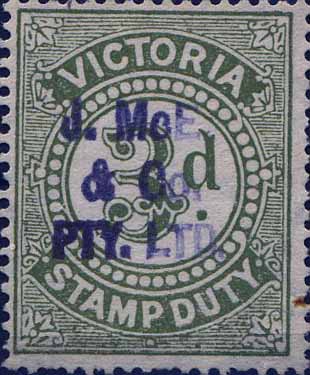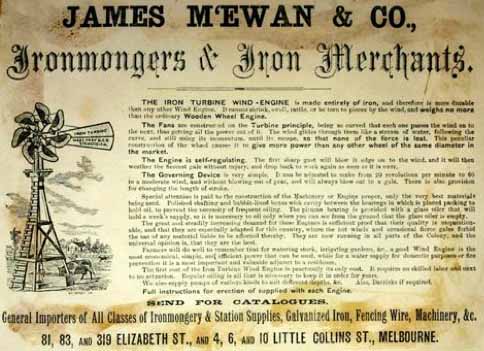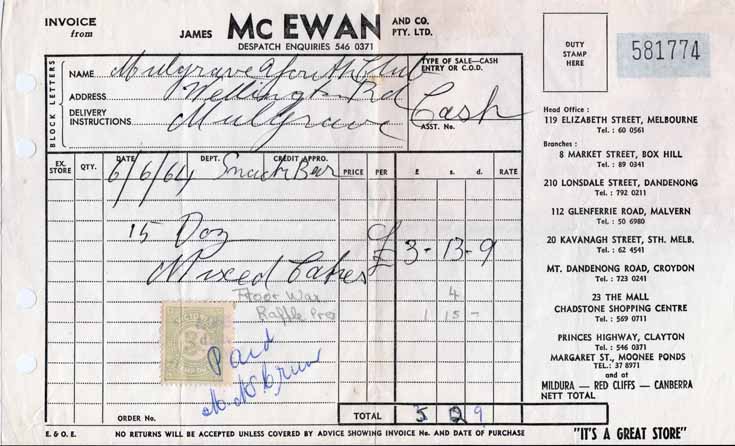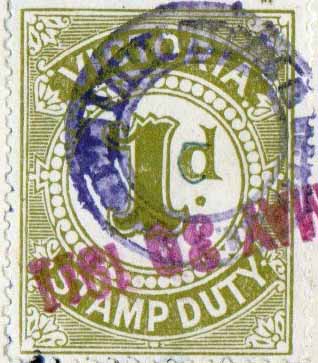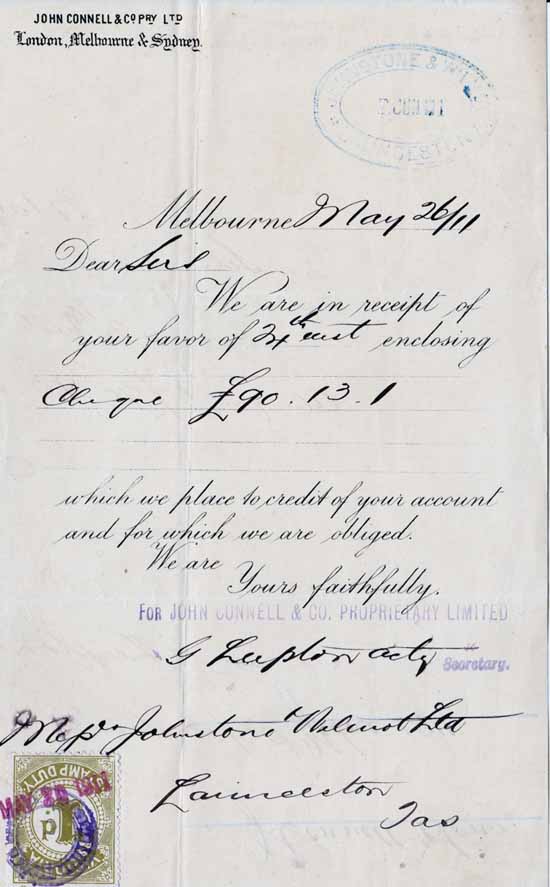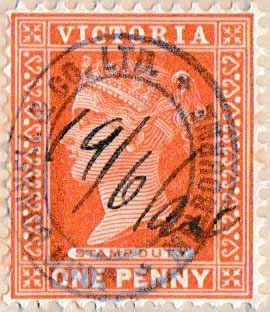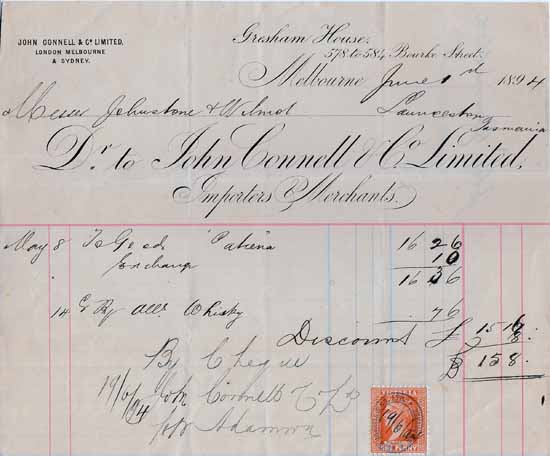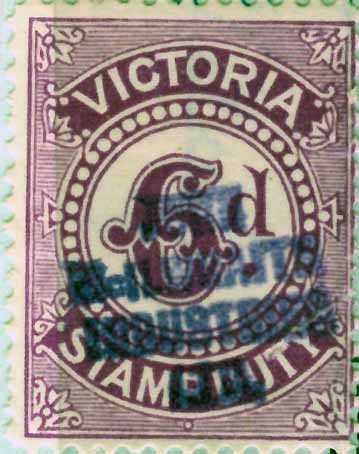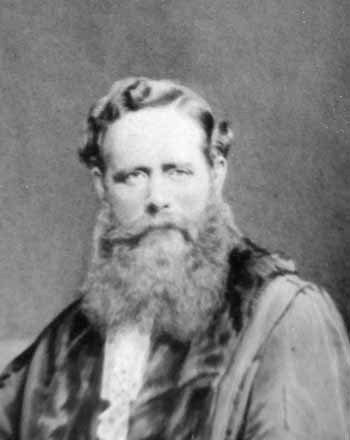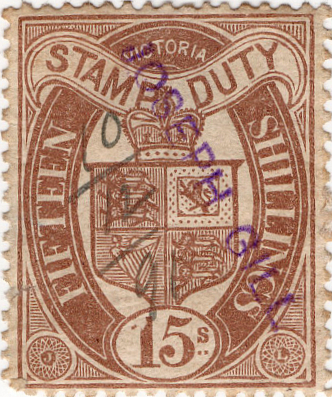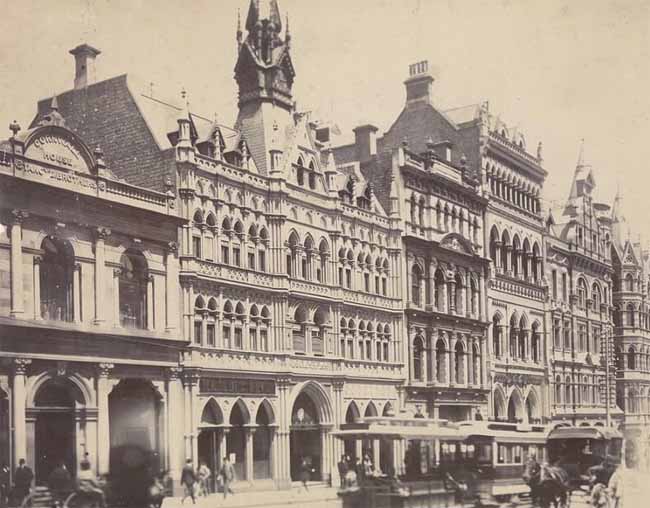|
Private Revenue Perfins of Victoria An Elsmore Coath Howard production The authors would welcome your comments additions or input into this work A B C D E F G H I J K L M N O P Q R S T U V W Y Back to Victoria 'Other' page Back to States Perfin index Back to Commercial Overprint index Section 2 - Commercial Overprints J
-------------------------------------------------------- J.B/&S.a
User:
J Bartram & Son Dairy
Equipment Manufacturers and Dairy product
merchants Address:
18 Queen St., Melbourne, VIC. From
about 1899: 19-23 King Street., Melbourne, VIC. From
about 1917: 586 Bourke Street., Melbourne, VIC. Revenue
Use: 1886-1899
Series, inscribed ‘STAMP DUTY’ 6d Rarity Scale 1886-1889 Series
6d R4 Background: #Jabez Bartram was born in 1826 in Bedfrshire and migrated to Victoria shortly after his marriage to Anne Haworth in 1848. In 1860 Jabez Bartram is found at Macedon Bakery in Riddell's Creek where he was a resident, standing for election (unsuccessfully) as a ("gentleman") candidate for West Bourke in 1871. Bartram & Co., diary produce merchants of 8 Queen St., Melbourne, was formed from a partnership between Jabez Bartram and Joseph Randin in about 1871. The partnership was dissolved in September 1872, and in May 1873, Jabez took his son, Haworth William Bartram into partnership, the business henceforth being styled Bartram & Son. In April 1891, Bartram & Son's address changed from no. 8 to no. 18 Queen St., Melbourne; the store, "late J. Bartram & So was put up for lease in September 1896, and the firm moved to premises at 19-23 King St. The company
became sole agents for Metropolitan Meat
Preserving Co. in 1873, the agency being retained for over two
decades. Bartram & Son would become the leaders in developing the export
trade in butter to England. By 1882, the company was "the largest exporters of
butter in the colony and also the largest
exporters of cheese,
and agents for several leading cheese factories"" (a statement from the Australasian Trade Review the
company continued to advertise for over a decade).
In 1885,
Bartram & Son became the sole agents for the
De Laval cream separators, selling and erecting
over 300 machines by 1889. (The De Laval
separators became the company's "golden egg". By
1890, the separator had won 60 gold medals at
international exhibitions. By 1893, "the Laval was
to be seen in every butter factory and creamery in
Victoria and also several hundred dairies".)
In 1888/9, Bartram & Son patented and were the sole manufacturers of the Eureka Butter Printer and Weigher, a machine which enabled 45 pounds of butter to be cut and shaped into half pound (or any other weight) rolls. In 1889, the company was the Department of Agriculture selected consignment agent for all Victorian butter for the London market, the Department having already secured all available shipping space. Danish butter realised higher prices in London than Victorian butter and in order to "all Victorian butter makers on an equal footing with the Danish competitors" Bartram & Son, in 1894, acquired the services of Mr Olsen who had "long and practical experience of butter making in both Denmark and Sweden" J. Bartram & Son became "Pty Ltd", in 1912, and moved to 586 Bourke Street. The company was still trading in 1955. Jabez Bartram died in 1880 (age 54) at his home in Kew, leaving an estate valued at..860. Haworth William Bartram, principal of J. Bartram & Son Pty Ltd, died in London in December 1918. Device: The JB/&S. a device was a single die customised device and this is proved by multiples which show no consistent relationship between strikes. The device came into service in 1894 and remained in use until at least 1908 when it appears to have been replaced by a similar looking device which was only in use for a short period. The withdrawal and replacement of the JB/&S. a device is difficult to fathom as it seems to have been in a sound condition and examples seen on postage stamps from 1907 and 08 show it is still producing clear and complete strikes. The pattern is common on postage stamps but very rare on revenues stamps where its usage is restricted to the pre 1901 period in which Victorian postage stamps were valid for use as revenue stamps. Related Patterns: Nil TROVE,
Jenny O’Donnell Research -------------------------------------------------------- J.McE./& Co./PTY. LTD..a User: James McEwan & Co General Ironmongery, (later) Furnishings Address: Bourke St, Melbourne, VIC 81-83 & 319 Elizabeth St, Melbourne, VIC 4-6 & 10 Little Collins St, Melbourne, VIC Revenue Use: 1911 Series 3d 1915 Series 2d 1930 Series 2d Rarity Scale:
1911 Series 3d R4
1915 Series 2d R4
1930 Series 2d R3 Background: During the long economic boom of the 1870s and 1880s, the leading Melbourne hardware store James McEwan & Co began distributing a comprehensive bound catalogue to its city and country customers. All types of domestic appliances, ironmongery, lighting fittings and even agricultural machinery were included. Device: Handstamp Related Patterns: Nil
-------------------------------------------------------- JOHN CONNELL Co. Pty. Ltd. Melbourne..a User: John Connell Co. Pty. Ltd Importers Address: 578-584 Bourke St, Melbourne, VIC Revenue Use: 1886 Stamp Duty Series 1d Rarity Scale:
1886 Stamp Duty Series 1d R4
Background: #John Connell was born in 1825,
in Kilmarnock, Scotland and migrated in 1848 to
Victoria, where he commenced trading as a
wholesale grocer at 15 Swanston Street, Melbourne,
in 1853. Device: Handstamped Related Patterns: John Connell & Co Pty Ltd.b Connell & Hogarth Pty Ltd.a
-------------------------------------------------------- JOHN CONNELL Co. Pty. Ltd. Melbourne..b User: John Connell Co. Pty. Ltd Importers Address: 578-584 Bourke St, Melbourne, VIC Revenue Use: 1886 Stamp Duty Series 1d Rarity Scale:
1886 Stamp Duty Series 1d R4 Background: See, John Connell Co. Pty. Ltd .a Device: Handstamped Related Patterns: Connell & Hogarth Pty Ltd.a John Connell & Co Pty Ltd.b
-------------------------------------------------------- JOHN/McILWRAITH/INDUSTRIES/LTD.a User: J McIlwraith Industries Ltd Address: 48-56 Lt. Collins Street, Melbourne, VIC Revenue Use: 1915 Series 6d 1930 Series 3d 1966 Series 5c Rarity Scale:
1915 Series 6d R4
1930 Series 3d R3
1966 Series 5c R4 Background: John McIlwraith was born in 1828 in Ayr, Scotland, where, on finishing school he entered his father’s plumbing business. He arrived in Melbourne aboard the ‘Janet Mitchell’ in January 1853, and immediately set off for the goldfields. McIlwraith formed a partnership with brothers Alexander and Francis Graham, painter and glazier by trade; the partnership of Graham, McIlwraith and Graham was dissolved in March 1854. For a few months in 1855 he was trading as McIlwraith and Davidson, before setting up on his own account in June 1853 at 112 Swanston Street, Melbourne. McIlwraith married in March 1854, and lived in Collingwood, from where he briefly carried on business, in a prefabricated iron house shipped out from Ayr. In November 1854, he moved his business premises to 147 Russell Street, where by 1857 he was advertising as “plumber and gasfitter” and “importers of all kinds of plumbers’ materials”. In 1859, McIlwraith purchased land in Little Collins Street and erected a building at 167-169 Little Collins Street, “opposite the Melbourne Club” into which he moved in November, 1861. John McIlwraith’s company would occupy the Melbourne Lead Works for the next hundred years.
In 1865 J. McIlwraith & Co. advertised as “manufacturers of sheet lead and lead pipes, plumbers’ brass work, pumps, gas fittings”.
In 1887, John formed a partnership with his brothers Andrew and Thomas in the Australian office of the shipping firm McIlwraith McEachern. In 1895, a bitter family row saw John McIlwraith force Andrew, to buy him out of the business. (Thomas McIlwraith was an astute businessman and politician, and one time premier of Queensland. He was given a knighthood.)
In 1890, McIlwraith formed a partnership with the Crane family of Sydney (G.E. Crane & Sons Ltd), which in 1893 saw the establishment of what later became called the Sydney Lead Works Ltd at The Glebe. (In 1903, when the Melbourne lead shot manufacturers Barker and Causey were commissioned to get the new shot tower for the Sydney Lead Works operational, the outcome was a takeover of the company by McIlwraiths.) In December 1937, Sydney Lead Works Ltd was absorbed into McIlwraith Industries Pty Ltd.
In 1893 John McIlwraith became a co-founder with Harold Crofton Sleigh (H.C. Sleigh & Co.) of a company formed to supply the Australian market with motor spirit under the ‘Golden Fleece’ brand (much later acquired by Caltex). The first delivery however did not occur until 1913.
John McIlwraith died in September 1902, while on a visit to Ayr, and was succeeded by his son Jack (John), his other sons, Thomas and David, also being involved in the family business. From the early 1900s, McIlwraith’s product range was sold through agents in most Australian states. On 20 August 1910, the family company became John McIlwraith and Company Proprietary Limited, with all shareholdings restricted to family members only.
By 1939, the company owned semi-retail stores in several Melbourne suburbs, but the first inter-state office did not open until the early 1950s, an era of rapid expansion for the company, when distribution outlets were acquired through take-overs and, in Victoria, through opening direct outlets. Some 21 companies would be acquired.
On 27 October 1950, John McIlwraith Industries Ltd was registered as a public company with a nominal capital of £2.5 million. Its purpose was to acquire the businesses of John McIlwraith & Co Pty Ltd and a number of subsidiaries, and J.D. McIlwraith Investments Pty Ltd, to further the expansion of the company, which was trading in all Australian states. The new entity was located at 48-56 Lt. Collins Street, Melbourne.
On 30 October 1950, a former John McIlwraith Industries Ltd subsidiary was spun off and registered as a private company, McIlwraith- Davey Pty Ltd. Located at Revesby, N.S.W. in 2017, the company manufactures metal sanitary ware products.
In 1951, a major share was acquired in Goldberg Brothers Pty Ltd (South Australia), and outlets were opened in Geelong and Dandenong, in Victoria.
In 1952, the Sydney Company became a wholly owned subsidiary. Etna Electrical Appliances Pty Ltd (Sydney) was acquired in 1953, followed by Coburg Iron Foundry Pty Ltd (Melbourne) (1954); L.J. Morgan Pty Ltd (Melbourne) (1954); Cistern Manufacturers Co. Ltd, (Brisbane) (1958); F.J. Wadham & Sons Pty Ltd (Adelaide) 1959; Jury & Spiers Ltd, (Adelaide) 1959; Hobart Plumbing Supplies Pty Ltd (1959); Metal Products Holdings Pty Ltd (Brisbane) (1960); Brent Industries Pty Ltd (Vic) (1960); Copper Products Pty Ltd (Vic) (1960; Buchanan, Cameron & Roberts Pty Ltd (Vic) (1960); L.D. Mee Investments Pty Ltd (Melb) (1961); C.R. Palmer Pty Ltd (Perth) (1961); E.A. Harper Pty Ltd (Sydney) (1962); Donson Products Pty Ltd (Sydney) (1962); Hazelhurst Pty Ltd (WA) (1963) Gibbs Pty Ltd (SA) (1964); Fred Clark Australia Pty Ltd (NSW) (1972).
Between 1968 and 1971, the company had a half interest in copper mines at Kitticoola (SA).
In March, 1972, John McIlwraith Industries Ltd acquired controlling interest in General Industries Ltd and so got rid of a difficult competitor and achieved dominance of enamel bath manufacture in Australia.
In 1974, Blue Metal Industries Ltd launched an unsuccessful take-over bid for John McIlwraith Industries Ltd and in 1977 sold their remaining shareholding to Oliver Davey Glass Ltd. By July 1978, a merger of the two companies was completed; the new company was called McIlwraith- Davey Industries and on 26 July 1979, John McIlwraith Industries Ltd de-listed by the ASX.
John McIlwraith was elected to Melbourne City Council as councillor for Albert Ward in 1870, becoming Mayor in 1873-74. He became a magistrate in 1874 and was a Melbourne Harbour Trust Commissioner in 1877-82. In 1876, he was Victorian commissioner at the Philadelphia Exhibition.
In 1954 to mark the centenary of the company’s founding the Chairman of Directors, John McIlwraith Smith, grandson of the founder endowed the University of Melbourne with £5,000 to establish a training centre for architects. Device: Handstamp Related Patterns: Nil Sources: Trove National Library of Australia. Australian Dictionary of Biography, https://adb.anu.edu.au/biography/mcilwraith-john-4098 www.delisted.com.au Nixon, N.V., Water and gas – a Scotsman from Ayr, publ. John McIlwraith Industries Ltd, 1977.
John McIlwraith -------------------------------------------------------- JOSEPH GILL.a User: Joseph Gill & Co Woolbrokers Address: The Olderfleet Building 447 Collins St, Melbourne, VIC Revenue Use: 1897 Stamp Duty Series 15/- Rarity Scale:
1897 Series 15/- R4 Background: Joseph Gill was born in Bradford, Yorkshire, in 1849, the son of Joseph, a “railway engine stoker”. By age 12, Joseph was already employed as an office boy (like his brother, John, born 1847, and his brother Samuel, born 1845, who had graduated to clerk.) He entered the wool buying trade at age 16, attending his first London sale as a buyer, representing a major Bedford firm, in 1868. Astute buying resulted in big profits and quickly established Gill’s reputation. In 1876, Joseph Gill arrived in Melbourne, probably with his brother, Samuel. He took up residence in Dryburgh Street, Hotham (North Melbourne) and immediately went into business as a wool buyer being the principal agent for the Yorkshire account, an account he held for most of his life. Gill would become one of largest wool buyers in Melbourne and “one of the oldest and best known wool buyers in Australia”. It was not until 1886, that “Joseph Gill, wool broker”, appears as an independent entity, located at 53 William Street, Melbourne, and was also an interim board member of China Traders Insurance Co. Ltd. In 1889, Gill re-located to 97 William Street. In September, 1891, the firm of Joseph Gill & Co., agents for the Gulf Line of steamers, opened at 99 William Street. The agency was secured by Walter Herbert Sollas, a partner in the firm, who became the local manager for the Gulf Line. The Line had 16 steamers with a monthly sailing from London and 6 weekly sailings from Glasgow and Liverpool. In November, 1892, Joseph Gill & Co. moved to The Olderfleet Building, 477 Collins Street, Melbourne (complete with telephone line) and became agents for the Greenock Steamship Co. Ltd as well. The wool-broking business was kept separate from the shipping business and it is not until 1898 that Joseph Gill, wool-broker, moves to The Olderfleet Building (475 Collins Street) occupying offices on the first floor. In 1896, the Gulf Line had vessels capable of shipping 40,000 carcasses and Joseph Gill & Co. had successfully shipped to England the first cargoes of frozen mutton from both the Portland and Geelong works. In January, 1921, Joseph Gill & Co re-located, for the last time, to 440 Little Collins Street. Joseph Gill died in April, 1926, aged 77, at his pastoral property ‘Winderradeen’ in New South Wales and was buried at Collector. The firm, Joseph Gill & Co., was carried on under a new partnership of Walter Herbert Sollas, William St Leger Burton and Eric Wheatley Sollas (W.H. Sollas’ son). Joseph Gill & Co. had been trading since the 1900s as joint shipping agents with Gibbs, Bright & Co. and in 1928 the two firms amalgamated, the company name of Joseph Gill & Co ceasing to exist. In February, 1931, William St Leger Burton (an executor of Joseph Gill’s Will) died aged 59, having spent more than 40 years with Joseph Gill & Co. Walter Herbert Sollas (the other executor of Joseph Gill’s Will) died in March, 1933, aged about 63. Joseph Gill had purchased ‘Winderradeen’ (6,000 acres), between Canberra and Goulburn, and bordered by Lake George, in November, 1906. “Although he spent little time at the station, he spent large sums of money turning it into a well improved and up-to-date property”. His brother Samuel appears to have lived at ‘Winderradeen’ for a number of years before his death there in 1924. Joseph Gill left an estate of £489,372, the chief asset being ‘Winderradeen’ station. In his Will, he left bequests to his two nieces, and legacies to Goulburn mechanics’ Institute, the Young Men’s Improvement Society, Girls’ Aid and Protection Society, Methodist and Anglican churches in Goulburn, a small legacy to the hall porter of Hotel Australia and ordered that permanent employees of Joseph Gill & Co. should each receive a sum equal to 3 month’s pay. The bulk of his estate however, was left to the Salvation Army divided in equal shares between the Melbourne, Sydney and Goulburn branches. ‘Winderradeen’ continued as a working sheep station until 1937 when the Salvation Army sold it. With the capital, Goulburn Salvation Army built a large brick meeting hall (later converted into a Senior Citizens’ Centre). In Melbourne, a former 5 storey tobacco factory at 217 A’beckett Street was purchased and converted to the Gill Memorial Home for Men (now a boutique hotel) while in Sydney, a residence named after the sheep station was provided for elderly women. Device: Handstamp Related Patterns: Nil
-------------------------------------------------------- A B C D E F G H I J K L M N O P Q R S T U V W Y Back to Victoria 'Other' page Back to States Perfin index Back to Commercial Overprint index © copyright 2011 |
